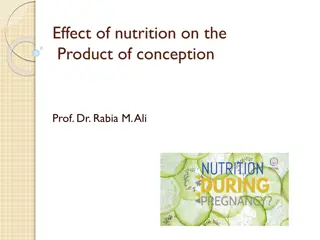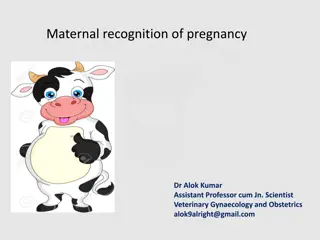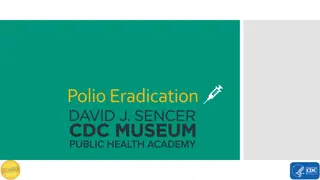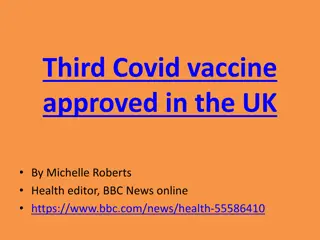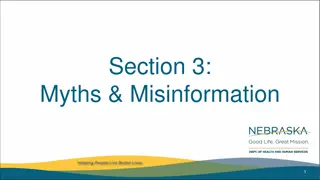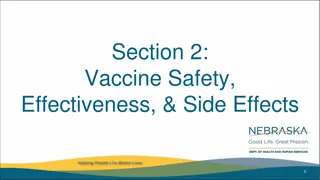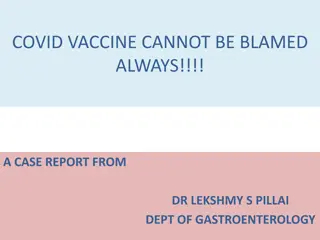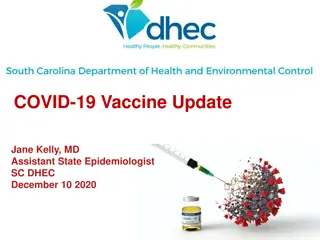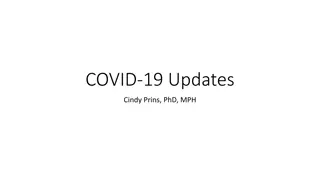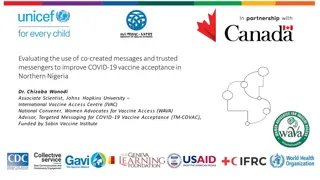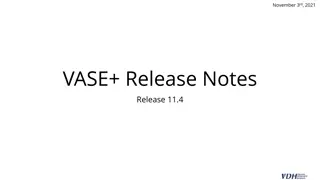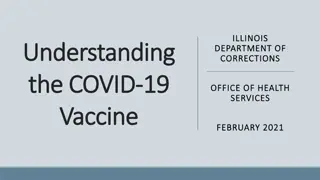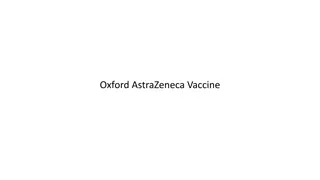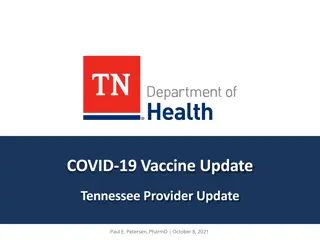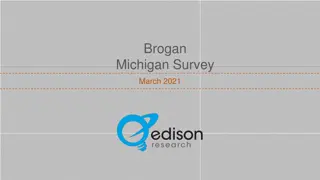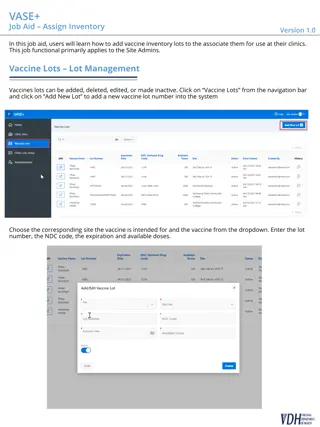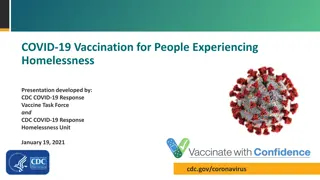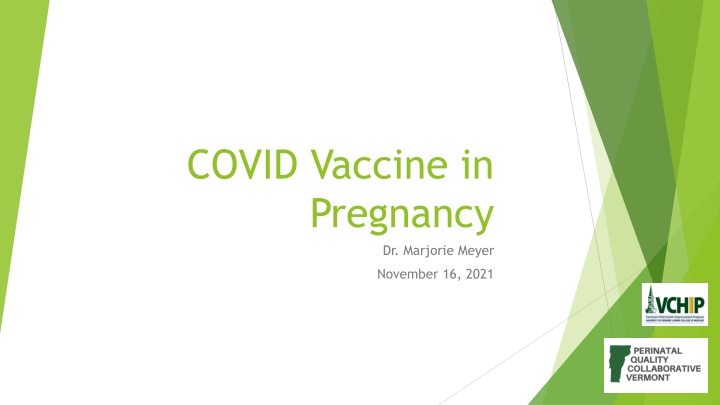
COVID Vaccine in Pregnancy: Updates & Guidance" (33 characters)
The impact of COVID infection on pregnancy, benefits and considerations of COVID vaccine during pregnancy and lactation, reviewed by Dr. Marjorie Meyer. Key topics include COVID progression, treatment, and vaccination. The presentation covers educational objectives, reminders, and disclosures. Visual aids and detailed insights are provided to enhance understanding. This comprehensive session will equip participants with essential knowledge to make informed decisions regarding COVID and vaccination in the context of pregnancy. (Maximum 499 characters)
Download Presentation

Please find below an Image/Link to download the presentation.
The content on the website is provided AS IS for your information and personal use only. It may not be sold, licensed, or shared on other websites without obtaining consent from the author. If you encounter any issues during the download, it is possible that the publisher has removed the file from their server.
You are allowed to download the files provided on this website for personal or commercial use, subject to the condition that they are used lawfully. All files are the property of their respective owners.
The content on the website is provided AS IS for your information and personal use only. It may not be sold, licensed, or shared on other websites without obtaining consent from the author.
E N D
Presentation Transcript
COVID Vaccine in Pregnancy Dr. Marjorie Meyer November 16, 2021
Reminders Please mute yourself upon entry and keep yourself muted while listening. You are welcome to ask questions throughout the presentation. Feel free to use the chat function, raise your hand, or unmute to ask your question directly. This presentation will be recorded and will be available for view. The recording will be emailed out to participants tomorrow along with a short satisfaction survey.
COVID and COVID Vaccine: Prepregnancy, Pregnancy, Lactation Marjorie Meyer MD Kelley McLean MD Maternal Fetal Medicine University of Vermont
Objectives/Educational Objectives Review COVID in pregnancy impact Review COVID treatment mRNA vaccine physiology Review pre-pregnancy vaccine (AKA: general public) Review pregnancy vaccine Review vaccination during lactation
Disclosures none
Pre-pregnancy: COVID infection https://en.wikipedia.org/wiki/COVID-19#/media/File:Fphar-11-00937-g001.jpg
Progression of COVID-19 I. Early infection Virus infiltrates the pulmonary parenchyma and replicates triggering an inflammatory response involving local vasodilation, increased endothelial permeability, leukocyte recruitment II. Pulmonary involvement Shortness of breath, cough, ground glass opacities on lung imaging COVID-19 pneumonia May rapidly progress from focal to diffuse bilateral consolidation of lung parenchyma IIa without hypoxemia (PaO2/FiO2 300 mmHg), PaO2 63mmHg on RA IIb with hypoxemia (PaO2/FIO2 <300 mmHg, PaO2<63 mmHg on RA) III. Severe hyperinflammation Marked systemic inflammation characterized by a cytokine storm (IL-6, IL-2, IL-7, TNF- , interferon- , IP-10, MCP-1, CRP, procalcitonin, ferritin) Severe damage to lung parenchyma progressive respiratory distress, multi-organ failure Pfeifer et al. Respiration. 2020.
Progression of COVID-19 Pfeifer et al. Respiration. 2020.
Total COVID cases, all ages: waves are clear CDC COVID Data Tracker
Total COVID cases, reproductive ages: waves are clear CDC COVID Data Tracker
COVID infections are not flattening yet in Vermont CDC tracker
Vaccination Works: Reduced risk of testing positive for COVID About 750/100,000 people of reproductive age will get COVID (~1%) each month if not vaccinated Reproductive aged unvaccinated people are 6x more likely to get infected with COVID CDC COVID Data Tracker
Vaccination Works: Reduced risk of dying from COVID About 4.5/100, 000 people of reproductive age will die each month if not vaccinated Reproductive aged unvaccinated people are 11x more likely to die from COVID compared to vaccinated people CDC COVID Data Tracker
COVID infection is dangerous for pregnant women 3% of pregnant women will get Covid if not vaccinated 0.6% of pregnant women will have severe or critical disease if not vaccinated 3.5 3 % pregnant patient with outcome Vaccination reduces severity of disease during pregnancy: Fewer infections Less severe/critical disease Less ICU admit 2.5 2 1.5 1 0 0 0 0.5 0 Unvaccinated Vaccinated OBGYN, epub 10/2021 Severe/Critical SARS-CoV-2 infection Maternal Death Oxygen requirement ICU admit
~0.2% of pregnant women with COVID required ECMO ~1.0% of pregnant women with COVID required intubation ~3.5% of pregnant women with COVID were admitted to the ICU
Delta Variant Pre-Delta 80 Delta variant outcomes during pregnancy are worse 70 Vermont is teeming with Delta variant GA delivery: Delta: 33.7 wks Pre-Delta 35.6 wks 60 % of patients with COVID diagnosis 50 40 30 20 10 0 0 OBGYN, epub, 2021
What happens when a pregnant pt is diagnosed with COVID? What that means: Frequent phone contact with office RNs (as often as daily if uncertain about progression) Consider SARS-Co-V monoclonal ab We delay prenatal visits and US if we can to complete the quarantine period (changed to 10 days by CDC) If pts need testing we occasionally request to be done in L&D if sufficient isolation can not be done in the office Follow growth Watch for preeclampsia Outpatient monitoring with a 14-day self-quarantine can be considered for pregnant patients with COVID-19 who have mild symptoms or are asymptomatic. Clinical judgment, test availability, community spread, and other local policies should be used to decide which patients are tested for SARS-CoV-2. Signs and symptoms of COVID-19 range from mild to severe and include fever, myalgias, cough, and difficulty breathing as well as gastrointestinal symptoms and anosmia in some patients. The CDC also recommends that depending on case burden and available resources, anyone with a close exposure should be tested immediately after exposure, and if negative, could be tested again about 5-7 days after last exposure or immediately if symptoms develop during quarantine. In most adult patients, if dyspnea develops, it tends to occur between 4 and 8 days after symptom onset, although it can also occur after 10 days. It is recommended that COVID-19 positive patients wear masks at all times and remain isolated, whether outpatient or inpatient, until convalesced, unless not feasible due to clinical care needs. SMFM Guidelines, 2020
Pregnant patients should be offered monoclonal antibody infusion if they get COVID Symptom scores were reduced my monoclonal ab administration Hospitalization: Day 29, % hospitalized: Placebo: 6.3% Antibody: 1.6% SARS-CoV-2 gains entry into cells through binding of its spike protein to receptors for angiotensin-converting enzyme 2 on target cells. Recommendation (CDC): Post exposure or mild disease (w/in 7 days exposure or 10 days of illness): The Panel recommends using one of the following anti-SARS-CoV-2 mAbs (listed alphabetically) as PEP for people who are at high risk for progressing to severe COVID-19 if infected with SARS-CoV-2 AND who have the vaccination status AND exposure history outlined in the text below. Bamlanivimab 700 mg plus etesevimab 1,400 mg administered as an IV infusion (BIII); or Casirivimab 600 mg plus imdevimab 600 mg administered as subcutaneous (SQ) injections (AI) or an IV infusion (BIII). LY-CoV555 (also known as LY3819253), a potent antispike neutralizing monoclonal antibody that binds with high affinity to the receptor-binding domain of SARS-CoV-2, was derived from convalescent plasma obtained from a patient with Covid-19.
COVID in pregnancy: BAD Vaccine: Substantial safety and efficacy data Concerns re: vaccination in pregnancy should be considered in the context of the considerable risk COVID infection in pregnancy portends
Historically, patients have embraced vaccine to reduce pregnancy risk: Congenital rubella, once common, now rare Rubella and CRS | Exploring Vaccines (wordpress.com) Rubella Virus (stanford.edu)
Outbreaks will occur until vaccination is available and accepted worldwide (note peaks in countries with vaccine available due to low vaccination rates in some areas)
COVID vaccines work, too Cumulative incidence of COVID infection after the first dose (pretty good by the time of second dose) DOI: 10.1056/NEJMoa2034577
mRNA vaccines (1) The main antigen that elicits immunity in native COVID infection is the Spike Protein (S protein). Both cellular (T cells) and humoral (neutralizing antibody) mechanism to this protein is the immunologic response to SARS-CoV2.
mRNA vaccines (1) The main antigen that elicits immunity in native COVID infection is the Spike Protein (S protein). Both cellular (T cells) and humoral (neutralizing antibody) mechanism to this protein is the immunologic response to SARS-CoV2. (2) The mRNA to the Spike protein is made and packaged in a lipid nanoparticle
mRNA vaccines (1) The main antigen that elicits immunity in native COVID infection is the Spike Protein (S protein). Both cellular (T cells) and humoral (neutralizing antibody) mechanism to this protein is the immunologic response to SARS-CoV2. The mRNA to the Spike protein is made and packaged in a lipid nanoparticle for atability and ability for the mRNA to enter the cell (3) The lipid nanoparticles containing the mRNA is injected IM; the particles enter the myocytes and the same cellular machinery that makes other proteins starts making the Spike protein from the mRNA (2)
mRNA vaccines (1) The main antigen that elicits immunity in native COVID infection is the Spike Protein (S protein). Both cellular (T cells) and humoral (neutralizing antibody) mechanism to this protein is the immunologic response to SARS-CoV2. The mRNA to the Spike protein is made and packaged in a lipid nanoparticle for atability and ability for the mRNA to enter the cell (3) The lipid nanoparticles containing the mRNA is injected IM; the particles enter the myocytes and the same cellular machinery that makes other proteins starts making the Spike protein from the mRNA (4) The Spike protein is secreted/expressed, identified by the lymphatic system, and the immune system does it magic (ask Liz) to create cellular and humoral immunity (2)
mRNA vaccines: mRNA vaccines: Noteworthy characteristics (1) mRNA is not stable and is naturally degraded in the cell when transcription job is done (days) (2) mRNA does not enter the nucleus and does not interact with DNA (no risk of insertional mutation, an issue with DNA based vaccines) (3) mRNA is NOT infectious (4) Given how mRNA vaccines act locally (at the site of injection) and are rapidly degraded and removed by lymphatic system, it is unlikely that the vaccine would reach and cross the placenta (G. Swamy, MD, SMFM)
mRNA vaccines: mRNA vaccines: Biologic Plausibility of placental interaction and effect of immune activation to COVID (1) mRNA is not stable and is a large molecule with a negative charge: even if it makes it to the placental interface, the biochemical characteristics suggest it would not cross the placental interface (2) Even if a lipid nanoparticle made the way to placenta, it might make Spike antigen and then stop just as the myocytes (3) The immune response to pregnant pts with covid and the vaccine are very similar: Ab and T cell response to the Spike protein. We know pregnant infected women are sick but no evidence that the immune response is harmful to mom or baby (and potential passive immunity). No biologic reason to think the antigen would be worse than the viral effects-which are largely related to maternal disease not the virus per se (4) We DO know preterm birth and maternal illness are bad
COVID vaccine is safe in pregnancy with similar local effects
COVID vaccine is safe in pregnancy with pregnancy outcomes similar to background rates in pregnancy
COVID Vaccine Effects in pregnancy: new medication, not much long term data COVID Infection Effects in pregnancy: new disease, concerning long term data (maternal and neonatal), treatment requires many new medications 100 90 80 % of women experiencing: 70 60 50 40 30 20 10 0
COVID infection is dangerous for pregnant women: Covid vaccination reduces severity of infection 3% of pregnant women will get Covid if not vaccinated 0.6% of pregnant women will have severe or critical disease if not vaccinated 3.5 3 % pregnant patient with outcome Vaccination reduces severity of disease during pregnancy: Fewer infections Less severe/critical disease Less ICU admit 2.5 2 1.5 1 0 0 0 0.5 0 Unvaccinated Vaccinated OBGYN, epub 10/2021 Severe/Critical SARS-CoV-2 infection Maternal Death Oxygen requirement ICU admit
Does COVID vaccine development use fetal tissue? Nature 2015
Rubella vaccine: Incubated in fetal cells Reduces the risk of congenital rubella Before 11 WG, the congenital infection rate approaches 90%, decreases to 30% between 24 and 26 WG and increases to nearly 100% beyond 36 WG Infection in the first 12 WG, the risk of major fetal defects nears 85%, with approximately 20% of the cases resulting in spontaneous abortions in the first 8 WG An estimated 20,000 cases of CRS occurred during 1964-1965 during the last U.S. rubella epidemic before rubella vaccine became available Since monovalent vaccines containing measles, rubella, and mumps vaccine viruses -- and subsequently combined measles-mumps-rubella (MMR) vaccine -- were licensed, the numbers of reported cases of measles, mumps, rubella, and congenital rubella syndrome (CRS) have decreased by more than 99%. About 30% of deafness worldwide is due to viral infection, largely rubella (Brazil: 32%) Mandated Vaccination: In 1977, ACIP modified its recommendations to include the vaccination of susceptible postpubertal girls and women. During the same year, the DHEW undertook the National Childhood Immunization Initiative, which sought to immunize greater than 90% of the nation's children against all vaccine-preventable diseases. Enforcement of requirements for vaccination before school entry was part of the initiative. The number of reported rubella and CRS cases decreased after these programs were implemented, from 20,395 rubella cases and 29 CRS cases in 1977 to 752 rubella cases and 2 CRS cases in 1984. In 1988, 225 cases of rubella were reported in the United States, the fewest since national reporting began. 1989 study: Of 242 college students with deafness, 104 were due to congenital to rubella CDC MMWR: May 22, 1998:
Does Covid19 vaccination cause infertility? No Here s Where That COVID-19 Vaccine Infertility Myth Came From And Why It Is Not True | Henry Ford LiveWell
Does getting the COVID vaccine cause miscarriage? No COVID Vaccine does not increase risk of first trimester SAB: Case: pts with SAB <14 weeks Control: Ongoing pregnancy Exposure: COVID vaccine in 5-week or 3-week window of SAB or ongoing pregnancy Adjustment: age, marital status, country of origin, education, income, number of children, employment
I do not want vaccination since it can hurt my heart. Mostly young males (Pfizer)
Myocarditis: Risk in highest risk group of young men: 14/100,000 people being vaccinated Covid infection young adults (18-34): ICU 21% Ventilator 10% Death 2.7% Covid infection Adolescent (12- 17): Cumulative hospitalization rate 50/100000 people ICU 30% Ventilator 5% Death 0 (200 cases) MMWR, June 2021

